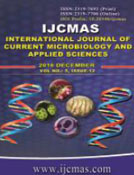


 National Academy of Agricultural Sciences (NAAS)
National Academy of Agricultural Sciences (NAAS)

|
PRINT ISSN : 2319-7692
Online ISSN : 2319-7706 Issues : 12 per year Publisher : Excellent Publishers Email : editorijcmas@gmail.com / submit@ijcmas.com Editor-in-chief: Dr.M.Prakash Index Copernicus ICV 2018: 95.39 NAAS RATING 2020: 5.38 |
Gram negative bacteria are highly adaptive pathogens that can develop resistance and evolve as Drug Resistant Gram Negative Bacilli (DR-GNB) by exhibiting Extended Spectrum Beta Lactamase (ESBLs), Amp C, NDM-1, Mcr-1 and Carbapenemase enzymes through several mechanisms. The main aim of this research was to study the prevalence of drug resistant gram negative bacilli in patients suffering from symptomatic urinary tract infections. After obtaining the IHEC clearance and informed consent form, nearly 820 urine samples were included in the study. Culture and sensitivity performed and various drug resistance patterns such as ESBLs, Amp C, K1 Enzymes, Carbapenemase production were detected and confirmed using various screening and confirmation tests. A total of 820 mid stream urine samples were collected from the subjects during the two months period. The mean age group of the study population was found to be 44.2 ± 0.2 years. Out of the 820 urine samples processed for Culture and sensitivity, nearly 166 samples (20.2%) grew bacteria and were termed ‘Culture positives’ and 654 samples (79.7%) were sterile and were termed ‘Culture negatives’. The incidence of Urinary tract infection was 20%. ESBL production was observed in 17 out of 140 isolates (12.14%). The antimicrobial resistance pattern is highly variable and a continuous surveillance of trends in resistance pattern is a borne necessity. To conclude Escherichia coli is the predominant pathogen isolated. The Prevalence of Drug resistant Gram Negative Bacilli thrusts a major therapeutic concern for the clinicians. Molecular method like Polymerase Chain Reaction is the Gold standard for confirmative diagnosis of these drug resistant bugs.
 |
 |
 |
 |
 |